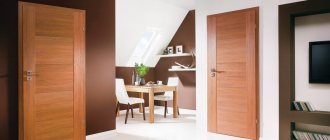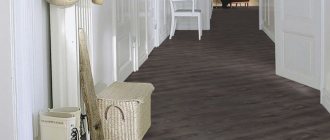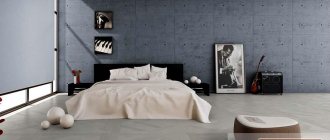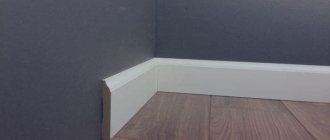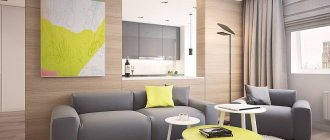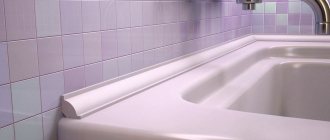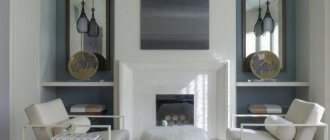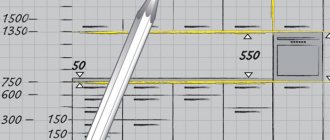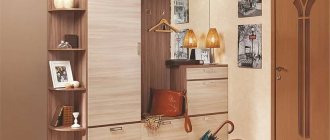Why do you need a plinth?
First of all, the plinth on the floor carries an aesthetic load. It gives the finish a finished look, but, in addition, it also closes the technological gap that is left when laying floor coverings. This gap is needed to allow the coating to expand and contract with changes in temperature and humidity. If this gap is not left, the coating will rise, move in waves, etc. But if you leave the gap open, debris will fall into it, and it looks unattractive. So the plinth strip closes the technological gap.
Choosing a plinth is not so easy. You need to choose the material, shape, size and color
There are also “special purpose” skirting boards. For example, with built-in lighting. They are good if you need dim diffused light in the dark. Any wall or ceiling lamps will “hurt the eye,” and illumination from below is the most gentle in this regard.
The second example of special skirting boards is with cable channels. They have been very popular lately. We need more and more cables to ensure a comfortable life. If a special channel is formed in the bar, a couple of cables can be laid in it.
What types of wood are plinths made from?
Coniferous trees (pine, spruce, larch, fir) have greater moisture resistance and are not subject to deformation when the humidity in the room changes. These breeds are easy to process.
Hardwoods such as oak, maple and hornbeam are considered more “noble”. However, they are quite difficult to process and have a significant drawback - dry air leads to cracks in the product.
Profiles made of soft hardwoods (cherry, walnut, linden) look beautiful, but high air humidity is “contraindicated” for them.
Advice. Treatment of decorative solid wood profiles with specially developed compounds protects the baseboard well when the humidity conditions in the room change.
Products made from exotic tree species are also offered for sale. Mention may be made of rosewood, wenge, merbau, jatobe and ipe.
A separate group is veneered profile. Inexpensive wood is used as the basis for its manufacture (usually pine is used). which is then covered with veneer of expensive wood species. The veneer is protected with a layer of varnish or melamine. This product has an affordable price, has increased moisture resistance and a beautiful appearance.
Types of skirting boards
If before there was no choice - only wooden planks, and not a very large assortment, today the number of positions can be a hundred or more, so there is plenty to choose from. Let's start looking at the types of skirting boards for the floor depending on the material.
- Made of wood. It is worth choosing a wooden baseboard if you have a wooden floor, parquet or parquet board. Moreover, the type of wood must match and the color, by the way, too. If you’re lucky, you can buy a ready-made one; if not, they’ll make it to order, but such finishing will not be cheap. Be sure to specify what should be made from dry wood, otherwise the products will later become deformed and even nails will not always be able to hold them in place.
- Skirting boards for flooring made of HDF or MDF. These are the same material, just different densities. A plank is formed from the mass, which is covered with a laminating PVC film or veneer. MDF baseboards covered with film are also called laminated. They are worth considering if you have linoleum or wood-look laminate installed. Match the color to the floor tone. The same type of molding can be matched to the color of the door trim. There are MDF baseboards that are sanded and ready for painting. There is room for imagination - you can paint it any color.
Made from MDF for painting - Plastic skirting boards for the floor. It is considered to be the cheapest, but this is not always the case. There are, of course, very cheap ones, but they also look appropriate, and there are more expensive ones. The more expensive ones may have cable ducts and rubberized edges. They are produced by laminate manufacturers. So when buying, think about the finishing. One manufacturer has a better chance of matching the baseboard perfectly to the floor covering. The match should be not only in color, but also in texture.
- Ceramic skirting boards for the floor. If the floor is tiled, you can make ceramic skirting boards. They can be matched to floor or wall decoration.
Ceramic baseboards are installed in the kitchen, in the bathroom, where ceramic tiles or porcelain stoneware are laid on the floor - Metal floor skirting boards. They are rarely found in apartments and houses, although many ultra-modern trends in design welcome metal. They are good in places with difficult operating conditions. They can be installed on the terrace, in an unheated vestibule, and so on. Typically made from aluminum, which can be polished, matte, or painted. There are options for laminated aluminum skirting boards. In this case, they can be matched to match the flooring or doors.
- Skirting boards for floors made of foam plastic or polyurethane, duropolymer. They are ideal for painting. If you want a plinth to match the walls, either use these or MDF. But, when using foam plastic, you need to be careful, since the material is not resistant to mechanical stress. Installation method: glue, additional fixation with nails or self-tapping screws is possible.
Polyurethane skirting boards can be low, medium or very wide, smooth or with ornaments
These are all traditional materials from which floor skirting boards are made. But material is far from the only selection criterion.
Wooden plinth (solid and veneer)
Wooden plinths are made either from solid hardwood, or from pine or plywood covered with valuable veneer. If you plan to paint your baseboards, then using expensive wood is not advisable.
Solid baseboards have the highest cost, and are most often used with expensive wooden parquet. Solid pine baseboards are much cheaper, but this type of wood is too soft and not resistant to damage.
Wooden skirting boards are the most environmentally friendly, but like any wood, they are not the most flexible and can be damaged by heavy furniture, leaving dents. This is especially true for veneered plinths and pine plinths. If installed carelessly, the wooden plank can easily split.
But plywood is multi-layered. Each layer is located perpendicular to the direction of the fibers of the previous one. Thanks to this, a plywood plinth is much harder than a wooden one, and is less damaged during careless drilling. But this strength is achieved through various impregnations and adhesives, among which the most common are those containing formaldehyde and phenol. The safest is plywood marked FBA. It uses natural albumin casein glue. Further down the gradation are FK (urea glue), FB (bakelite varnish) and the least environmentally friendly FSF (resin phenol-formaldehyde glue).
Wooden baseboards are sensitive to changes in humidity, so they are not used in bathrooms. But in general, this is one of the best options, and such skirting boards will last for years.
Methods for installing wooden skirting boards: screws, rails, clips, glue.
How to choose a plinth: what to choose
First of all, the question arises: why, exactly, should we select it? To the doors? Flooring? Yes, but there are other options:
- To the door and cash. In this case, the doors are connected into a single system. Most often this technique can be found in the corridor or hallway. That is, where there are a lot of doors and it is they who mainly attract attention.
Choosing a baseboard to match the color of the doors is one of the basic rules, but this is far from the only way to select a color - Choose a white baseboard. This technique works great with light walls. It can also be used with more saturated colors, but this is more difficult and you need to look at the interior as a whole. Visually, the white plank in the floor area expands the space and does not “burden” the interior.
The room looks more spacious and brighter - Select a baseboard to match the floor covering. This choice is justified only when the pattern and shades match one to one. Even a small difference will be noticeable.
You can match the baseboard color to the laminate from the same manufacturer. Or take a piece of coating with you and look in shops/markets - One of the universal ways for living rooms is to paint the baseboard in the color of the walls. It works great with plain walls, but you can choose one of the shades, even if the walls are colored, with an ornament or pattern. Many modern styles go this way.
The current trend is the same color of the baseboard and walls - Choose the color of the baseboard to match one of the finishing elements. Picture frames in one color look most logical. There may be frames for medallions to match the furniture and even textiles. True, when changing textiles, you will also have to repaint the baseboard strip. But this allows you to quickly and inexpensively change the style of the room.
As you can see, before choosing the color of the baseboard, you need to create the interior, so the color is often decided on last. The exception is if you decide that the color should match the floor covering. This decision is often made if they plan to lay laminate on the floor. Then it’s easier and easier to take the moldings right away with the laminate.
Wooden plinth installation technology
Fastening begins from the corners of the room. The skirting boards are connected to check the correct joint. If there are no gaps, then begin fastening. When the quality of the joint is poor, the sections of the boards are treated with a grinder or sandpaper. Upon completion of the work, the joints are puttied to match the wood. The technology for fastening solid wood and veneer is different.
Installation of solid baseboard
Marking with self-tapping screws
Solid wood plinth is fastened with self-tapping screws - this is a complex method of fastening. After marking and cutting, make markings for the screws, observing the specified distances so that the fastening points are level. After all, it is impossible to completely disguise them
The standard distance between screws is 0.8-1.2 m, the distance from the floor covering is 1.5-2 cm. Attention! If you use thin, long self-tapping screws with small heads and high fastening capacity, then they are almost invisible.
Screws are screwed into the places where the fasteners are marked until they look out from the back side. Then they apply it to the wall, press the floor covering, and screw it in until it stops. There will be recesses on the wall from the fasteners that need to be drilled and dowels inserted there.
Final commit
The product is applied to the wall and finally screwed.
The plinth can be mounted on nails. The procedure is similar, but instead of plastic dowels, wooden ones are inserted.
Installation of veneered plinth
Scheme for fastening a veneered plinth
The veneered plinth does not narrow or expand, so you can use 3 methods for fastening: screws, glue, clips. The first method is identical to fastening a solid baseboard with self-tapping screws.
The second method is installation with a special glue, which makes it possible to avoid holes, but the surface of the walls must be smooth, otherwise cracks will be visible. Before starting work, the walls are sanded to an ideal look, cleaned, and the baseboard is glued to the wall with liquid nails.
The third method is to use a clip to attach a wooden plinth to the floor, thanks to which it is possible to remove it from the fastener at any time (for laying cables). A clip is attached to the surface, then a plinth with a groove is put on it.
Finished floor covering, varnished
After installation, the plinths are puttied, sanded and covered with 2-3 layers of varnish or painted.
A correctly selected wooden plinth and the appropriate method of fastening will help to complete the final stage of floor processing with high quality. If the technology is followed, then the appearance of the floor with plinth will delight, create coziness and comfort.
How to fix a solid baseboard:
average rating
more than 0 ratings
Share link
Choosing a mounting method
In addition to all the above points, you also need to choose the baseboard according to the method of fastening. In general, they can be attached to the wall or to the floor. But when laying laminate, parquet, parquet boards, boards - fastening only to the wall. Why? Because the listed materials have significant thermal and moisture expansion, therefore, a gap is left along the perimeter of the flooring - between the edge of the flooring and the wall, which is closed with a plinth strip, but the flooring material is not fixed - it must move freely. This is only achieved when the plinth is attached to the wall. It only adheres to the floor, leaving the covering room for movement.
Elastic edges are no different. Neither in color nor in texture
To prevent dust and debris from getting under the bar, use an elastic sealant. It remains mobile even after drying, so it leaves freedom of movement for the floor covering. The second option is strips with rubberized edges. Very convenient and practical.
There are several ways to attach skirting boards:
- Through. The simplest and most reliable, but not the most beautiful.
- Gluing. It’s also not difficult, but it’s only possible with smooth walls and not with all models of skirting boards.
- Secret. There are at least three options:
- the base part is attached to self-tapping screws/dowels, which are covered with a decorative strip;
This is just a secret fastening. A good model that is easy to install yourself - on the guides.
on clips;
Mounting on guides (top left) and clips (bottom right)
With a hidden mount, not everything is so simple. This is only possible with smooth walls and floors. The simplest and most reliable is when the base is mounted on the wall. As a rule, these are models with a cable channel. In models with clips and guides, the reliability of fixation depends on the design. And it is worth considering that after removing the bar from the mount several times, it will have to be replaced - the groove becomes wider than necessary for reliable fixation.
Selection Basics
When choosing, they start from the color of the floor, door or walls. An interesting design solution can be obtained by choosing a baseboard that contrasts with the color of the floor and walls. But in order for such a solution to look harmonious and beautiful, you need to have taste.
If the plinth is selected to match the texture and color of the walls, then it is purchased after finishing the final finishing. This will allow you to take into account the resulting shade of the wall and choose the ideal tone. As a rule, the plinth is chosen after the repair of the walls and floor is completed.
When laying parquet or other wooden covering, it is best to immediately select or order a baseboard for the floor from the same manufacturer. This will allow you to get an element from the same type of wood and the same tone as the main floor.
The plinth puts a logical point in finishing the floor and walls
The most difficult choice is based on the color and texture of the doors. In this case, the plinth is designed to emphasize not only the floor, but also the door frame.
How to choose by size
First of all, you need to take care of the width. The plinth must cover the technological compensation gap. It is better if its width is at least 5 mm larger. They can be from 3-4 cm to 15 cm in height. So the choice is quite large. So which skirting board size should you choose? The width is clear. There is no longer a gap. What about height? You need to look at the interior and what role you assign to it.
The size of the baseboard depends on the proportions of the room and how much you want it to stand out
It's worth choosing a low one if you don't want to draw too much attention to it. If the plinth strip is just a detail, and not the “main player” in the interior, low or medium height - up to 5-6 cm - is what you need. If they are assigned an important role in the interior, then they are made tall - about 10 cm and above. But high baseboards with low ceilings or in small rooms are not the best choice. In general, you need to look at the proportions of the room, but you can never go wrong with average ones.
Match the color of the floor
Floor covering and baseboard of the same color is the most common solution for our realities. This plinth does not stand out, does not attract attention and remains almost invisible.
Photo: fabriziafrezza.it
Choosing a baseboard to match the floor is not always easy. If there is no element on sale that matches the color, you should think about purchasing a skirting board for painting. These products are made of wood, MDF, LDF. They are sold primed or already painted.
You can paint the baseboard both before and after installation. The same paints that are used for wall decoration are suitable for painting. The paint must be tinted to the desired shade that matches the color of the floor covering. If you are not satisfied with the result, you can always repaint the baseboard, making it a little darker or lighter.
Some skirting board manufacturers also provide painting services. The buyer himself sets the color, and then picks up the finished products.
